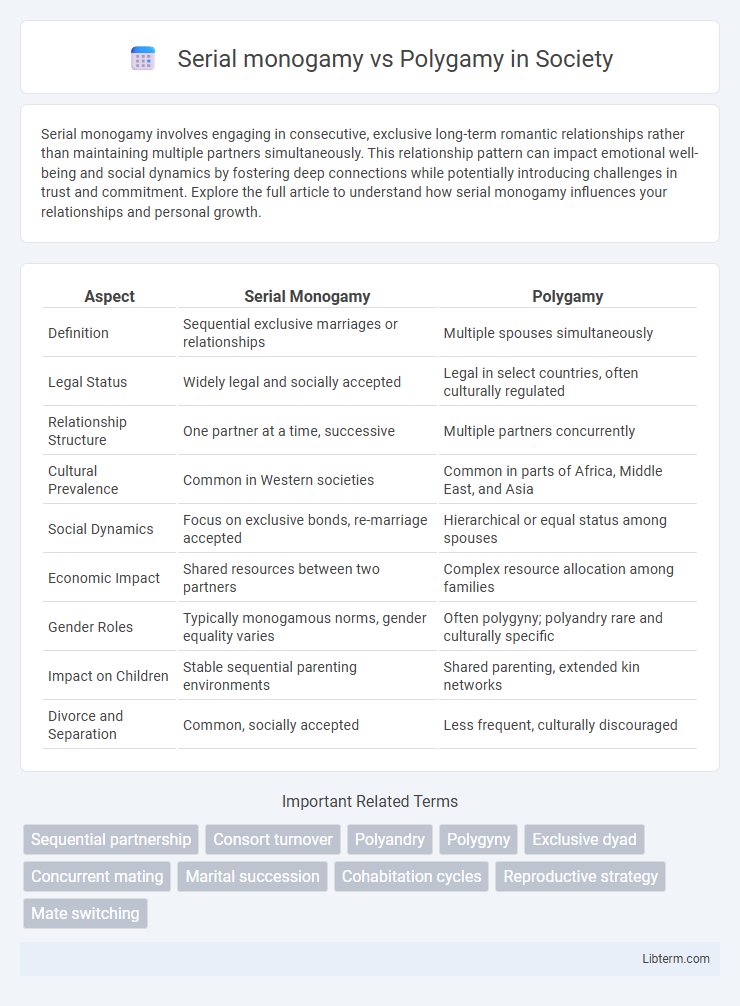Serial monogamy involves engaging in consecutive, exclusive long-term romantic relationships rather than maintaining multiple partners simultaneously. This relationship pattern can impact emotional well-being and social dynamics by fostering deep connections while potentially introducing challenges in trust and commitment. Explore the full article to understand how serial monogamy influences your relationships and personal growth.
Table of Comparison
| Aspect | Serial Monogamy | Polygamy |
|---|---|---|
| Definition | Sequential exclusive marriages or relationships | Multiple spouses simultaneously |
| Legal Status | Widely legal and socially accepted | Legal in select countries, often culturally regulated |
| Relationship Structure | One partner at a time, successive | Multiple partners concurrently |
| Cultural Prevalence | Common in Western societies | Common in parts of Africa, Middle East, and Asia |
| Social Dynamics | Focus on exclusive bonds, re-marriage accepted | Hierarchical or equal status among spouses |
| Economic Impact | Shared resources between two partners | Complex resource allocation among families |
| Gender Roles | Typically monogamous norms, gender equality varies | Often polygyny; polyandry rare and culturally specific |
| Impact on Children | Stable sequential parenting environments | Shared parenting, extended kin networks |
| Divorce and Separation | Common, socially accepted | Less frequent, culturally discouraged |
Definition of Serial Monogamy
Serial monogamy refers to the practice of engaging in a series of exclusive, monogamous relationships, where an individual has one partner at a time but multiple spouses over a lifetime. This form of relationship differs from polygamy, which involves having multiple spouses simultaneously. Serial monogamy is prevalent in many modern societies, emphasizing consecutive committed partnerships rather than concurrent ones.
Understanding Polygamy
Polygamy is a marital practice where an individual has multiple spouses simultaneously, often categorized into polygyny (one man with multiple wives) and polyandry (one woman with multiple husbands). This form of marriage is prevalent in various cultures and legal systems worldwide, influencing social structures, inheritance laws, and gender dynamics. Understanding polygamy involves recognizing its cultural, religious, and legal contexts, which differ significantly from serial monogamy, where individuals have one spouse at a time but may have multiple sequential marriages.
Historical Perspectives on Relationship Styles
Historical perspectives on relationship styles reveal that serial monogamy emerged predominantly in Western societies during the Industrial Revolution, reflecting changing social and economic structures that emphasized nuclear family units. Polygamy, deeply rooted in many indigenous and ancient cultures, often served social, political, and economic functions such as alliance-building and resource distribution. These contrasting relationship models demonstrate cultural adaptation to environmental, economic, and social pressures over time.
Cultural Influences on Relationship Choices
Cultural influences significantly shape the preference for serial monogamy or polygamy, with societies valuing individualism often favoring serial monogamy as a reflection of personal freedom and emotional fulfillment. In contrast, many traditional cultures endorse polygamy, rooted in social, economic, and religious frameworks that emphasize family alliances and community status. Anthropological studies highlight how these cultural norms govern relationship patterns, impacting legal structures and social acceptance worldwide.
Emotional Impacts of Serial Monogamy
Serial monogamy often leads to emotional exhaustion due to repeated cycles of intense bonding and subsequent separation, which can impact long-term mental health. Individuals in serial monogamous relationships may experience difficulties in trust and attachment, increasing feelings of insecurity and vulnerability. Compared to polygamy, where multiple relationships coexist, serial monogamy requires continuous emotional adaptation to new partners, possibly intensifying emotional rollercoasters and relational stress.
Social Dynamics in Polygamous Relationships
Polygamous relationships often feature complex social dynamics involving hierarchical structures and negotiations of power, influenced by cultural norms and individual roles within the family unit. Emotional and resource distribution challenges frequently arise, affecting interpersonal bonds and community cohesion. Understanding these dynamics requires examining the impacts on social support networks and gender relations within polygamous settings.
Legal and Ethical Considerations
Serial monogamy is legally recognized in most countries, allowing individuals to marry multiple partners consecutively but not simultaneously, while polygamy remains illegal in many jurisdictions, often facing strict legal penalties. Ethical considerations involve debates on individual rights and cultural norms, with serial monogamy aligning with Western ideals of exclusive commitment and polygamy challenging traditional definitions of marriage. Legal systems frequently prioritize protecting spousal rights and preventing exploitation, influencing the regulation and societal acceptance of both practices.
Benefits and Challenges of Serial Monogamy
Serial monogamy offers benefits such as emotional renewal and the opportunity for personal growth through successive committed relationships, fostering adaptability and resilience in partnership dynamics. Challenges include emotional strain from repeated breakups and the complexity of blending past relational experiences into new commitments, which may impact long-term stability and trust. In contrast to polygamy, serial monogamy emphasizes sequential exclusivity, potentially reducing legal and social complications but requiring continuous emotional adjustment.
Advantages and Disadvantages of Polygamy
Polygamy allows for expanded family networks, increasing social support and economic cooperation among members. However, it often leads to challenges such as jealousy, unequal resource distribution, and legal complications in many jurisdictions. The complex dynamics can impact emotional well-being and create disputes over inheritance and parental responsibilities.
Evolving Relationship Trends in Modern Society
Serial monogamy, characterized by consecutive exclusive relationships, reflects evolving dating patterns influenced by greater social mobility, changing gender roles, and increased individualism. Polygamy remains less common in modern society but persists in certain cultures and legal frameworks, with debates focusing on ethics, legal recognition, and gender dynamics. Shifts toward digital dating platforms and shifting cultural norms contribute to the dynamic landscape of relationship structures and societal acceptance.
Serial monogamy Infographic

 libterm.com
libterm.com